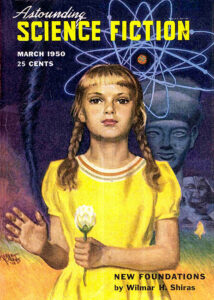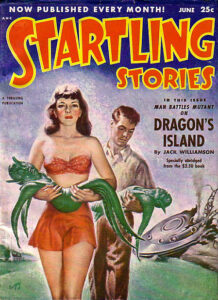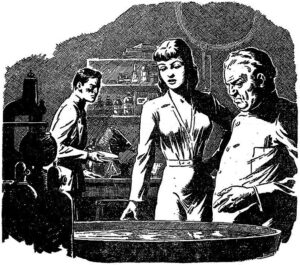
Last month, I took a look at a pair of sf stories from 1940s that featured mutants. The premise of the post being that the X-Men weren’t the first time mutants — or evolved humans — appeared in popular fiction.
No doubt, consciously or not, [inlinetweet tweeter=”yellowedperils” suffix=” #pulpmags #xmen @marvel”]pulp sf stories provided a lot of inspiration for the X-Men[/inlinetweet], just as the magazines had done for Superman, Batman, and many other comic-book heroes. (You have to remember that many of the early comic-book writers, illustrators, and editors had pulp magazine backgrounds, and if they didn’t, they were likely avid pulp readers.)
Several newsgroup comments after my first post suggested two other stories as precursors to the X-Men. Shelby Vick over in the PulpMags group at Yahoo and Charlie Eckhaus in the FictionMags group both mentioned the Children of the Atom series, which ran in Astounding Science Fiction from 1948 to 1950. And FictionMag’s Art Lortie mentioned “Dragon’s Island,” an abridged version of which ran in the June 1952 number of Startling Stories.
Children of the atom

The Children of the Atom series consisted of three short stories by Wilmar H. Shiras. She later used those stories as the beginning of a 1953 novel titled Children of the Atom.
After reading Norvell W. Page‘s But Without Horns (or A.E. van Vogt‘s retro-Hugo nominee “Slan,” for that matter) mentioned in the previous post, Shiras’ trilogy may seem somewhat ponderous. The plots of her stories move along through the dialog.
In “In Hiding,” which appeared in the November 1948 Astounding, psychiatrist Peter Welles discovers Timothy Paul, who as the story’s blurb says is “a 10-year-old boy pretending to be an ordinary 10-year-old boy.” Timothy has an astronomical I.Q., and while he seems to be a quiet and unassuming kid, has already secretly mastered many fields, such as architecture, genetics, and even fictioneering.
Timothy explains why he’s living a pretend life:
“I’m afraid of being found out, of course. The only way I can live in this world is in disguise — until I’m grown up, at any rate. At first, it was just my grandparents scolding me and telling me not to show off, and the way people laughed if I tried to talk to them. Then I saw how people hate anyone who is better or brighter or luckier. Some people sort of trade off; if you’re bad at one thing you’re good at another, but they’ll forgive you for being good at some things, because you’re not good at others and they can balance that off. They can beat you at something. A child has no chance at all. No grownup can stand it to have a child know anything he doesn’t. Oh, a little thing, if it amuses them. But not much of anything. There’s an old story about a man who found himself in a country where everyone else was blind. I’m like that — but they shan’t put out my eyes. I’ll never let them know I can see anything.”
Welles learns that Timothy’s parents were exposed to radiation following an explosion at an atomic plant; they died from the radiation exposure soon after he was born.
This story and the next two — “Opening Doors” (March 1949) and “New Foundations” (March 1950) — follow Welles, and Timothy, as they search for the other orphaned “children of the atom” and make plans to set up a special school for them — all without letting others know about the abilities of these super-intelligent mutants.
Other than the children experiencing troublesome reactions from adults and other kids, there’s no overt human-versus-mutant conflict in these stories. The focus is on discovering the children, and establishing a safe environment that lets them take full advantage of their super-intelligent abilities and prepare them for a new world.
That’s the same goal behind Professor Charles Xavier‘s School for Gifted Youngsters in the X-Men comic books in the early 1960s and the movies today. (There was a six-issue comic-book miniseries called X-Men: Children of the Atom from 1999. Its title reflects the loose structure — of Professor X gathering mutants for his school — that’s echoed from Shiras’ stories.)
Dragon’s Island

Jack Williamson takes a more action-driven approach in his novella “Dragon’s Island” than Shiras did in her series. Williamson’s story first appeared hardback in 1951, and what appears in Startling Stories in 1952 (and what I read) is an abridged version.
Geneticist Dane Belfast finds himself in the middle of a conflict between humans and the mutant (but awkwardly named) “not-men.” Funding has been cut for his genetics lab, and Belfast has traveled to New York City to meet with J.D. Messenger, the head of the Cadmus Corp., which had been underwriting his work. But before he has a chance to get to Cadmus, he is approached by two unknown groups.
Belfast gets a cold call from Nan Sanderson of the Sanderson Service, who seems to know he’s in town, asks him to visit her office the next day, and warns him that he’s in danger from a fellow named John Gellian. A few minutes later, Belfast runs into Gellian, who identifies himself as a private detective, in the lobby of his hotel.
Within a short time, a reporter that Belfast is helping discover what’s behind the Cadmus Corp. is been brutally murdered, and Belfast himself wakes up with complete amnesia and in the hands of Sanderson and Messenger. He’s flown to New Guinea where he’s put to work understanding genetic manipulation and attempting to recreate a species of small, green plant-men being used as slaves. Meanwhile, he wants to know what’s really going on in the highly secured genetics research lab.

While the mutants have expanded psychic abilities and above-human strength, there’s no all-out battle between them and the humans. “Dragon’s Island” is a much more scaled-down adventure about a handful of people. (If you’re looking for X-Men-like superheroes or titanic action, neither of these has that.)
Art Lortie, over on the FictionMags group, pointed out two examples of how Williamson’s story appears to have directly influenced the comics:
- One of the pivotal characters of “Dragon’s Island” is name Vic Van Doon. Hmmm, that sort of sounds like the Fantastic Four‘s arch enemy Victor von Doom in the Marvel universe.
- Cadmus Corp. is reflected as the DNA Project in October 1970’s Superman’s Pal Jimmy Olsen by comics titan Jack Kirby for DC Comics. The genetic research laboratory later became known as Project Cadmus.
Of the four mutant stories from the pulps that I’ve looked at, both the Children of the Atom series and “Dragon’s Island” are the better-written ones. But, “Dragon’s Island” does bog down for a few pages as Messenger explains his mutant theories to Belfast, but once that’s over the pace resumes.
All of these stories are built on a tension between the “normal” and the “different.” The status quo is afraid of being eclipsed by the smarter and stronger mutants, whether they are evolved or transformed. The same tension underlines the X-Men in both comics and movies since the early ’60s, and the stories in Marvel’s Agents of S.H.I.E.L.D., Captain America: Civil War, and Superman v. Batman: Dawn of Justice.
If your experience has been only comic books, TV, or tent-pole movies, you should make an effort to seek out stories from the pulp magazines. You’ll be surprised at how the stories, characters, and themes from those old, tattered pages are echoed in our current pop culture.


